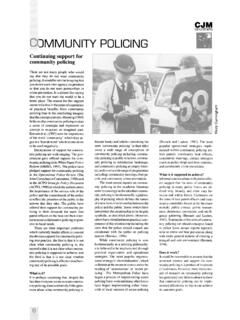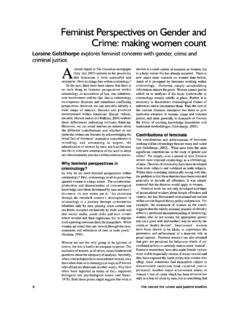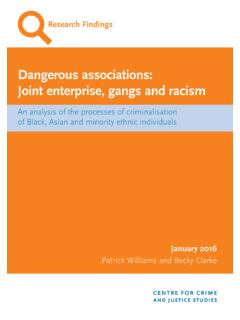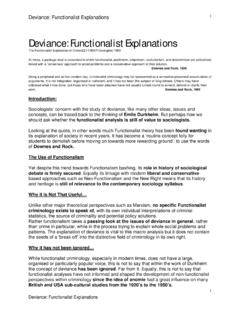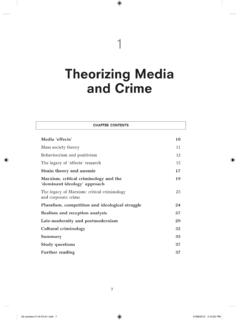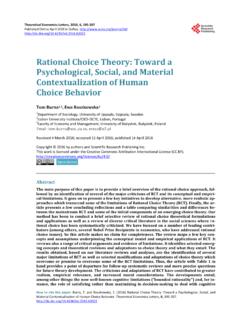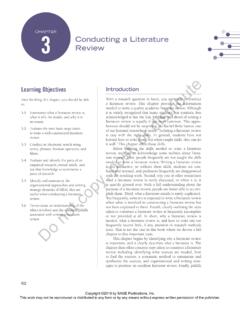Transcription of GENDER AND CRIME
1 CJMCRIMfflALJUSTICElWrTEESGENDER AND CRIMEM asculinity, femininity andcriminologyAs many criminologists have observed,thinking about GENDER is inextricablylinked with thinking about CRIME . TimNewburn and I observed recently, "themost significant fact about CRIME is that itis almost always committed by men."(1994:1) Compared to their proportion inthe population, women are under-represented amongst those cautioned orfound guilty for indictable offences inEngland and Wales and constitute a smallminority of the prison population. Whengender is discussed in criminology orcriminal justice matters at all, ittraditionally highlights the plight of"The most significant factabout CRIME is that it is almostalways committed by men.
2 "(Newburn and Stanko, 1994).women: as judges, lawyers, victims orthieves, women have been, and many stillargue, are, the outsiders. The purpose ofthis article is to provide a framework forthinking about GENDER , one whichappreciates GENDER , both as masculinitiesand feminities, and which uses thisappreciation to explore how CRIME reflects,resists, reinforces, and reproduces widergendered structures in the offender male?One in three men in the UK will have aconviction for a serious offence by theage of 31. Overwhelmingly, it is men whocome to the attention of police, the courts,the probation service, and the this, we tend to overlook this fact:why have we failed to see the men withinthe criminal justice system and its taken-for-granted male frame?
3 Indeed, much offeminist criminologies have sought toexplore the impact of this frame on thetheorising and treatment of women' s crimeand is the cost of neglectingmasculinities on our ability to theoriseand on our practice, for the men who workin that system, who are assessed andjudged by it, and who, as outsiders,attribute 'evilness' to (mostly) men'scriminal indiscretions without recognisinggender? As Joe Sim recently observed inan essay on prison and imprisonment, weseemed to have simply overlooked whata gendered reading might look like: wehave, he suggests, been more concernedwith "men as prisoners rather thanprisoners as men" (1994:101).
4 There is, however, growing attentionto the lens of masculinities, reflecting anapproach to the study of the operations ofcriminal justice or in thinking aboutoffending and victimisation which firmlylocates men within various forms ofmasculinities. I use the term'masculinities' here to acknowledge thecontribution of Bob Connell's (1987)theorising about what he terms hegemonicmasculinity. As an ideal type, hegemonicmasculinity is relational, ideological anddynamically constructed: it operates as asystem of dominance among men andbetween women and men. It is thereforeimportant to account for relations amongmen, and, as some have begun to observe(see Newburn and Stanko 1994), this is aparticularly useful theoretical device inthe study of CRIME , criminal justice Connell's work (and there areothers now theorising about masculinityand CRIME specifically, see Messerschmidt[1993]), it is possible to theorize aboutwhy, for example, young men, especiallyyoung black men, have been the target forpolicing and 'management' by the stateover time.
5 Structural features of society -those located in class, race or GENDER - willbe reproduced and challenged by men tomen. An understanding of howmasculinities are structured helps us makesense, say, of the continuous angst aboutmarginalised (or not), young men'sviolence, such as football hooliganism, orjoy-riding (sic). Ken Polk's new book,When Men Kill, for example, argues thatusing masculinity as a central feature ofanalysis, one can begin to make sense ofmale-on-male confrontations (themajority of homicides and reportedassaults) and risk taking involved inrobbery and homicides as features ofmasculine violence.
6 Without thinkingabout male bonding and machismo, couldwe grasp any features of police culture?Remarkably, though, theovershadowing of maleness withincriminal justice is largely treated as taken-for-granted, the normal background ofWithout thinking about malebonding and machismo, couldwe grasp any features of policeculture?deviance and criminality. It is only whenwomen as perpetrators intrude into thisspace that the 'problem' of criminalwomen causes concern. Explanations forwomen's participation in CRIME remainheavily laden in biological orpsychological paradigms. Womenoffenders are nearly always treated asaberrant females, or as masculinized(Lombroso noted their 'hairiness').
7 Asmany researchers suggest, women'srelationship to femininity, rather than theircriminality, influences their treatmentwithin the criminal justice system. Asfeminist criminologists arrived on thescene in the late 60s and early 70s, theynoted the paucity of information onwomen and what information did existseemed to coalesce around stereotypes ofthese errant , it seems, still onlymeans many ways, feminist criminologistscontinue to be the only ones who makewomen visible in the study of criminality,criminal justice professionals, andvictimisation. GENDER , it seems, still onlymeans female. What then about ourthinking about victimisation, a field alteredby the evidence generated by feministknowledge about sexual and physicalviolence?
8 Isn't this where women finallyfeature prominently?Is the victim female?Clearly, the second wave of the women'smovement has had a major impact inthinking about victimisation: establishingrefuges for battered women; exposingand confronting often appalling treatmentof raped and sexually assaulted women atthe hands of individual men as well as theinstitutions of criminal justice; andquestioning the very characterisation ofhow blame is routinely shouldered by therecipients of violence - all of whichchallenged the official picture of crimeagainst women as rare. Moreover, asfeminist criminologists continue to show,the criminal danger women confront morefrequently occurs at the hands of spouses,male acquaintances and relatives.
9 Thework on violence against women has atleast shaken the image of faceless assailant(though, as I continue to argue, notenough).No doubt, developments in criminaljustice policy and recognition of 'thevictim' had an impact on how victims arecharacterised. Victim surveys, and therise of Victim Support, provide portraitsof victims, which are often, as Paul Rock(1990) suggests, fragmented. Vaguely,there has emerged a sense that 'victims'needs' should be met, and those needs areoften characterised as needs arising fromCJM No. 19. Spring 953 GENDER & , injury and lackof informal and the elderlywere particularly targetedas 'needy', and this islargely, though notexclusively, the casetoday.
10 We think of victimsof CRIME as struck bytragedy, attention hasbeen focused on thoseexperiencing violence orthe intrusion of is there an implicitmessage about GENDER inboth that contributes toour knowledge about victims?Victims are characterised as those whoare "least powerful", and "leastdeserving" of criminal violation. The focuson violence against women and the needsof the elderly exaggerated a view ofvictims as in need of assistance, as doubt, by making visible thewidespread fear of sexual violence, itshidden incidence, and its connections with'normal' heterosexuality, feminists whostudied violence against womenconsciously located women's experienceof men's violence within women'sgendered experience.

